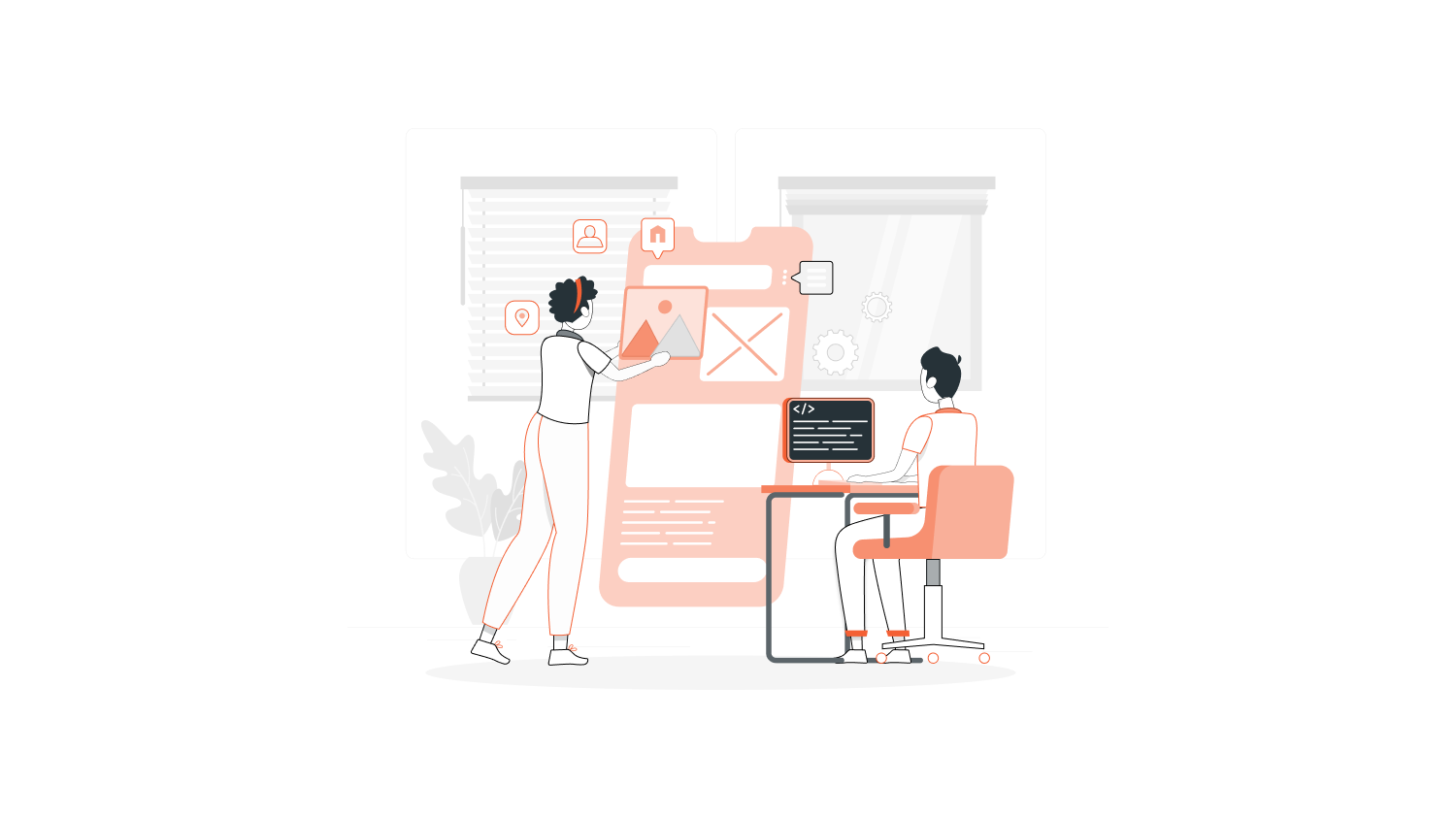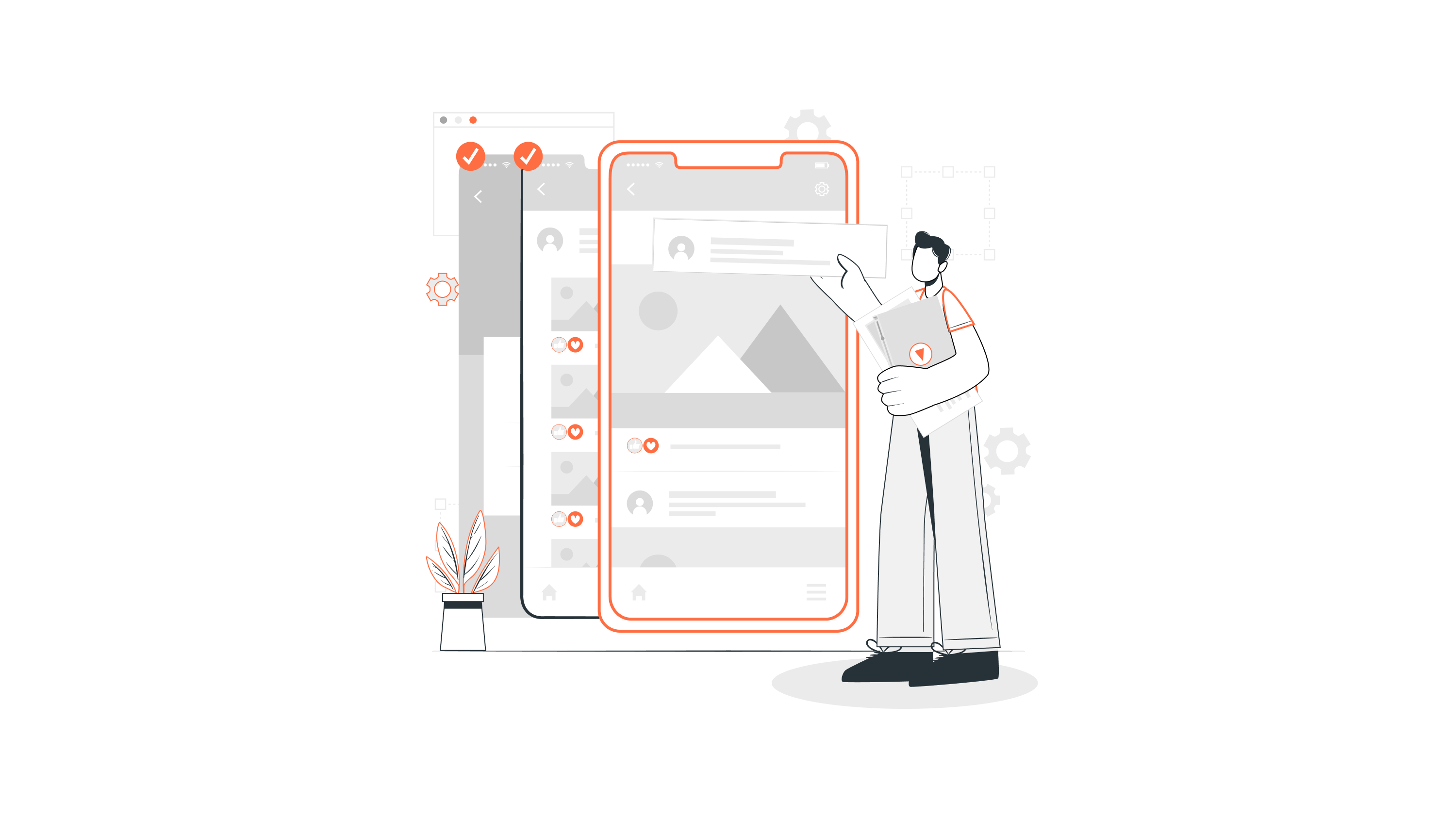So, you need a mobile application for your company. Have you told anyone yet?
It’s possible that you are drowning in a sea of suggestions as to how to go about building your mobile app, especially if it’s your first time. The possibilities seem limitless, don’t they? And also a bit overwhelming, perhaps?
Where do you start?
An idea? Okay, so what comes next? Should you hire a development team immediately and get started? Or should you get a consultant first? Should you discuss your idea with your team first? Or try to pen it down for more clarity before you show anyone? Do you focus on form or functionality?
Relax.
We recommend you just read this article from top to bottom.
It will give you a clear idea of how you should ease yourself into the app development process, one foot at a time. Having a clear idea of the steps involved will help you plan your app development project better and streamline the entire project for optimal results. It will also ensure that you won’t accidentally miss out on any important steps while you’re running around trying to manage the project.
Since you’re here, either you are a non-technical stakeholder trying to understand the intricacies of app development, or you’re a developer looking to refresh your memory. It doesn’t matter if you are not well-versed with technical jargon because we have simplified the points for you.
Just stick to these steps to create your mobile app without having to address too many hiccups along the way.
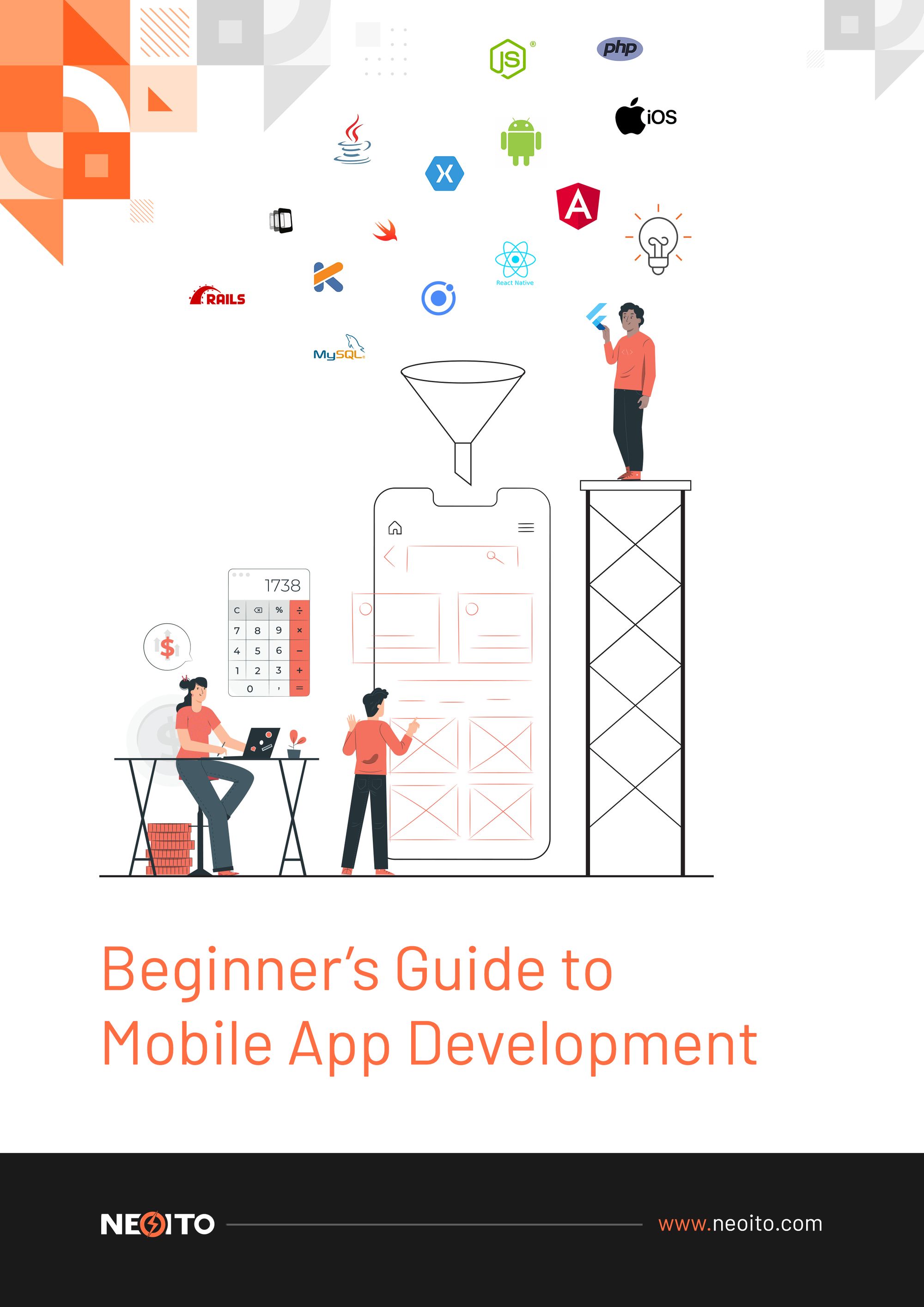
Free Download
A Complete Guide to Mobile App Development
Identify an Opportunity
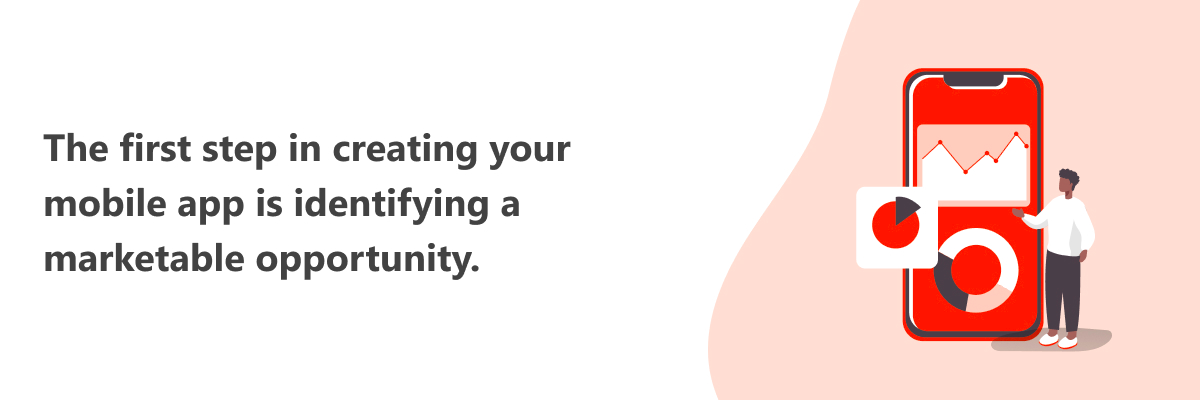
What demand are you trying to cater to with your application? What service do you wish to offer? Does your app have a unique selling point? How can you reach your audience with your app? Can your app simplify the lives of your users in any way? Why should users download your app?
You need to do copious amounts of market research to identify your niche in the marketplace. If you already have an app idea, you need to study the idea and its relevance in today’s market. Your app needs to bring a fresh offering that people can get behind easily.
For example, an app that helps users have essential commodities delivered to their doorsteps is relevant in today’s world. However, an app that lets you do simple mathematical calculations is obsolete. Everyone has a calculator at home or built into their phones!
Look into your target users and understand their needs. It is these needs that you must address with your new mobile application.
Suggested Read: 11 Productive Mobile App Development Tips for Startups & Small-Scale Businesses.
Reinforce Your Idea
All right, you’ve finally hit upon an idea you think is good. Now, write it down. Let’s figure out if it’s really worth a million dollars.
You can’t rush into the app development process as soon as you get an idea that you feel might be viable. Confirming your idea is an important step you simply cannot avoid.
You need to indulge in some SWOT (Strengths, Weaknesses, Opportunities, and Threats) analysis. Access the strengths of your idea.
What are you bringing to the table? Understand your weaknesses. How can you improve your idea? Figure out your opportunities. How can you streamline your app to ensure maximum benefits? And finally, predict the potential risks that your app development project might face. A thorough SWOT analysis will give you more clarity about the viability of your idea.
Lastly, don’t forget to do a competitor analysis. You don’t want to make an app that’s a facsimile of another app that is already popular among users.
Do Some More Research

This might seem like too many steps focusing on research. But, bear with us.
Research is an extremely crucial aspect of any product development, not just a mobile application. Your work isn’t done after you establish the desirability of your app and mark out your competition.
Once you have reinforced your app idea, you need to figure out the team members you need and the tools you will use to turn your app into a reality. How many team members will you need? What are the skills they need to bring to your team?
What are the tools you plan to use for project management? What tools will you equip your developers with for project development? Some of the tools available are paid versions. This means you need to factor in this decision while deciding on your budget too. How else can you estimate the total costs your app development will likely incur?
See why we insisted on dedicating another step to research?
Find Your Dream Team
The next step, and a very important one, we might add, is finding a team of expert professionals who are driven towards excellence. Your team can make or break your app development project. Find the right team and you could build an app to conquer your marketplace. Pick the wrong team, and you could end up a sad statistic.
What sort of developers do you need? Are you going to focus more on aesthetics or functionalities, that is, do you need more UX developers or back-end developers? Or would you prefer to get the best of both worlds and focus more on full stack developers?
It’s not enough to have a team of industry experts. You need team members who are passionate about their work. You need a team that is constantly striving to raise the bar for themselves and those around them, such as NeoITO, a reliable app development company.
Never make impulsive hires, as this can cost you dearly as your project progresses. Analyse each potential team member carefully before you roll out the welcome wagon.
Read the Ultimate Guide to Hire Freelancers for Your Startup Business in 2021.
Figure Out Your Core Features and Functionalities
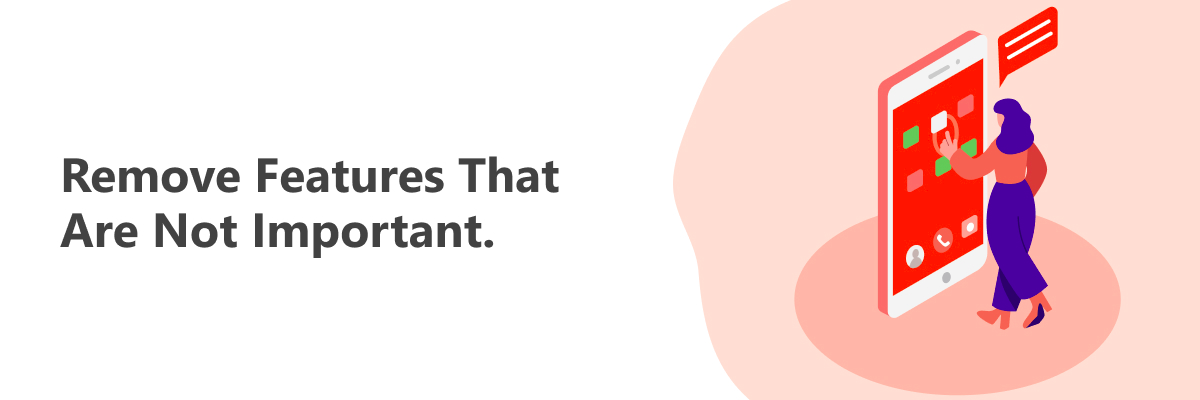
Now, for an exciting step that can seal the bond between you and your new team. It’s time to decide on the core features and functionalities you wish to include in your app. Don’t be shy about throwing ideas around, because you will be able to refine the features and functionalities later.
As the product owner, you must give clarity to your development team. Indulge in requirement elicitations to give you an idea about the features that your target users would expect from your app. This will also help you remove unnecessary features, which will save you time and effort in the future.
Why waste resources on developing a feature or functionality that most of your target users won’t benefit from?
Sit with your team and define users and user stories. User stories will help you understand how you can add value to your users’ lives and create user experiences that will leave lasting impressions.
Map Out User Flow
Next, you need to map out user flows. A user flow is the typical path taken by your end users while they use your mobile app. For example, if you were to create an online shopping app, your app’s user flow would start from the time a user onboards your platform and starts searching for a product or service. The user flow would take your user through product searches to the checkout process. It’s important to create good user flows to improve user comfort.
Your user flow ultimately sets a navigational path for your end users. In order to create good user flows, you need to identify your user’s needs. Understand what all information they will need to navigate your application smoothly and provide that information at the right times. User flows play an important role in user conversion and user retention over a period of time. So, you need to define user flows that ensure your users are not bored or confused.
Your user flow will also depend on the functionality of your app. For example, if you are designing an app to help vaccine distribution to your community, you should ensure that it is easy for everyone to onboard your app, even those who are aged or less skilled with technology.
Build a Wireframe
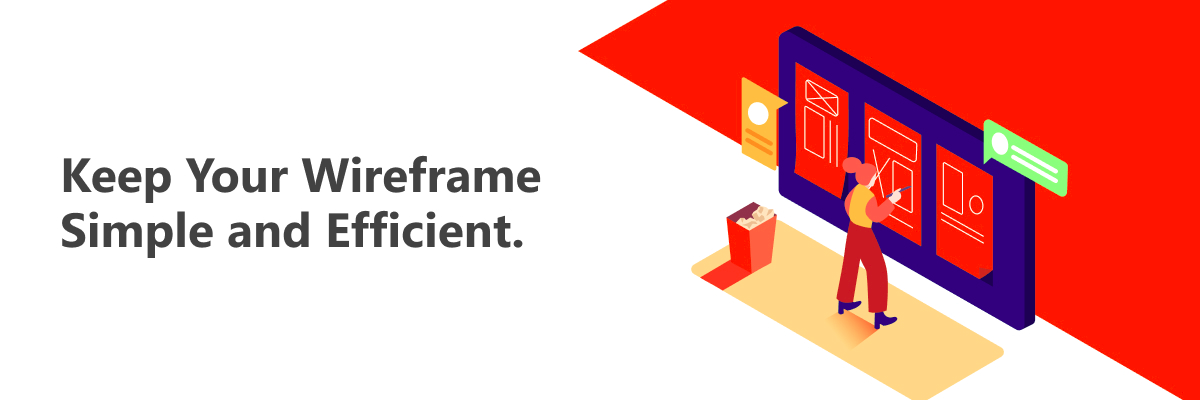
You now know your user flows. Next, it’s time to build a wireframe for your application. A wireframe gives you an idea of how your application will look once it’s completed.
It will help you analyse and rectify (if required) some points that you will need to consider as your project progresses.
Does your app interface look similar to the idea you had in mind? Will your users be able to navigate your app easily to complete their tasks? Does your wireframe structure comply with the expected needs of your users? What could be the possible questions that your first-time users will have in mind when they use your app?
Your wireframe does not need to be detailed or complex. A rule of thumb is to keep the design as simple and effective as possible and focus more on the functional aspects. The purpose of a wireframe is to help you test your navigational paths and content placement. Where should the application content ideally be placed? Where should the widgets and banners be positioned?
Your wireframe should have some of the common design elements, including headers, footers, body content, breadcrumbs for easy navigation, and Call to Action (CTA) buttons.
Suggested Read: 15 Easy Steps to Build a Successful e-Commerce Mobile App.
Select Your Technology Stack
Before we go any further, we need to give importance to some behind-the-scenes action. It’s time to finalise your technology stack! Your technology stack will include all the frameworks, technologies, and tools that you will use to develop your app, such as programming languages and data storage.
A technology stack can usually be broadly classified into four categories: front-end development, back-end development, development platform, and any other additional component. The front end will focus more on design and visual aesthetics, as it is the user-facing side of your application. The back-end focuses more on functionality. The development platform will hold your libraries and can be Android, iOS, or hybrid.
Both front-end and back-end are equally important, but more priority can be assigned to one depending on what you expect out of your app. For example, let’s say you give importance to your front-end and develop a beautiful interface. You will attract a lot of users who are eager to try your app. But if your back-end cannot handle the excessive load and crashes, your app has failed.
You need to dedicate some time to finalising your technology stack as it plays an important role in protecting the privacy of your users and the future scalability of your app.
Read: Top 12 Reasons to use React Native for your Mobile App Development
Design Your App

Now, for the fun part! You have your A-team and your tools ready. It’s time to design your app and turn your sandcastles in the air into a functional app for your end users.
This step includes designing the architecture of your app. What domain do you want to use? What about the hosting servers? Do you need to incorporate a Content Management System (CMS) to increase your virtual presence once your app is ready to go live?
Designing your app is no mean task, and we urge you to move with the necessary caution. The design architecture of your app will determine the future scalability of your application. Give particular emphasis on having a clean and clutter-free design, as you do not want to overwhelm your users.
Your design should cater to usability, functionality, and easy navigation. It would also benefit your business if you incorporate proper branding and good colour schemes into your app design, as it will ultimately increase brand recall in your users.
Calculate the average app development cost in 2021?
Create a Prototype
A prototype is a simple and functional version of your final product. You don’t need to spend a lot of time on it, and it’s advisable to keep it simple.
A prototype is very useful as it gives you a visual representation of your app idea. This will help you analyze your app’s functionalities, fix bugs and errors, and improve the overall app before you start developing the final product.
It also helps you with investor pitches as investors are more likely to be convinced about giving you their backup if you can support your app idea with a visual model. You can also start user testing and let your users interact with your app before it’s made commercially available. This will increase the chances of a positive reception from your audience when your app goes live.
You can even use your prototype to patent your app idea. To know more about why you need to build a prototype for your mobile app, read our article about the importance of prototypes.
Why Should You Create a Prototype for Your Startup Idea?
Validate Your Prototype
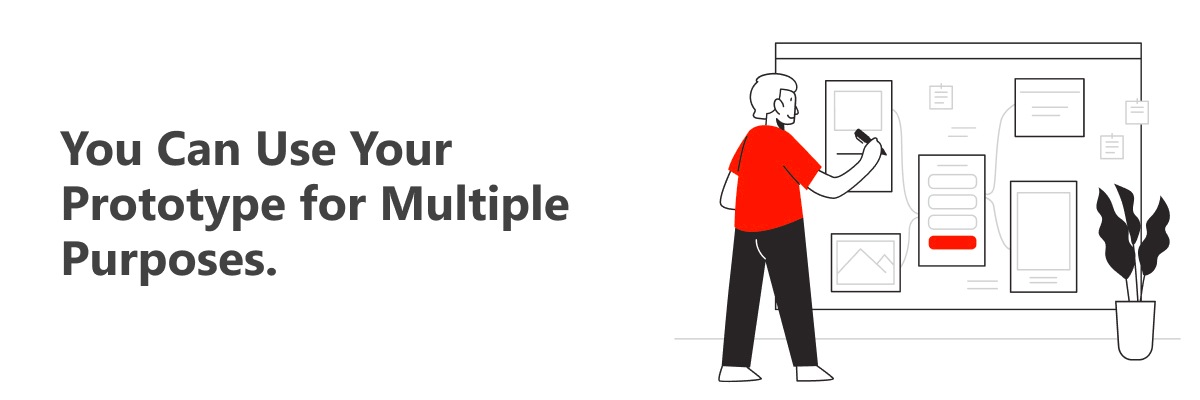
Once you have a full-scale prototype ready, it’s time to validate your idea and efforts. Test your prototype for functionalities and understand how you can improve your app. Make sure everything is working as you intended it to.
Your end user should be your primary target while analysing your prototype. You need to conduct user testing to see if you’ve done a good job of ensuring user comfort while navigating your app. Will your users enjoy using your app? Are they getting stuck anywhere in the user flow? How can you make your app simpler and more interactive for your users?
You can also conduct feasibility studies to understand your scalability potential with the help of your prototype.
Start Marketing
Wait, did we just tell you to start marketing? Without a final product? Before you even started your app development?
Yes, we did. And we’ll tell you why.
The marketplace is highly competitive and it’s possible that another team of developers is working on the same idea as you right now. Make sure you beat them to the punch and start marketing your idea as soon as you have a prototype that has been validated.
Having a prototype will help you market your final product almost as effectively as having a fully functional app. It gives users a chance to get accustomed to your app as well, which means they’ll be ready to get their hands on it as soon as you release the Alpha version.
Starting your marketing early in the app development process will also allow you to understand how well you can connect with your target audience. What are their preferences? What are the functionalities that they would like to see in your finished product?
You will get a chance to refine your marketing strategies and hone them to perfection by the time you launch your app and engage in fully-fledged marketing.
Check out the top Mobile App Development trends to rule in 2021.
Improve Your Features and User Flow
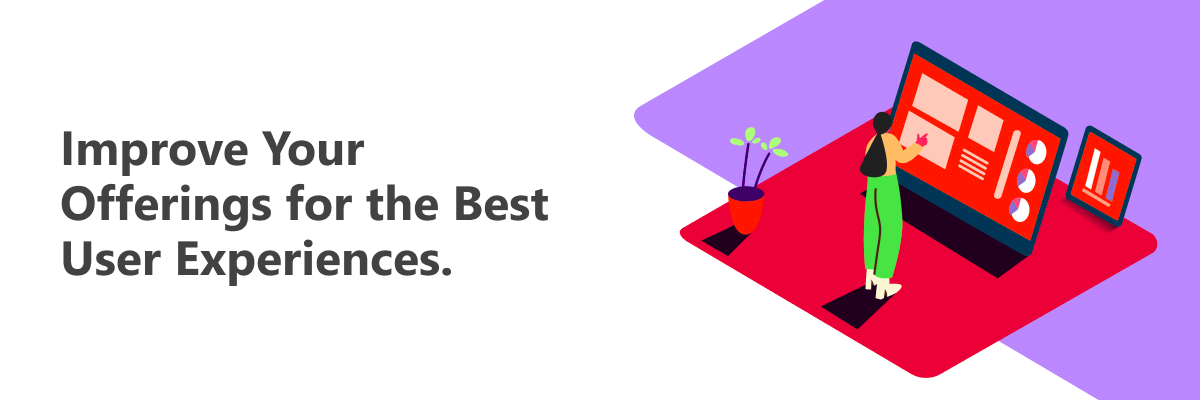
There is always room for improvement if you want to create the best user experiences for your audience. You already have a prototype that your users are actively engaging with and you have the insider information on what exactly your users want from you. Prototypes and initial marketing. Wink wink.
Now use all this data and work out what makes your users tick. Should you perhaps add a chatbot as a core feature? Maybe you can make the navigation a bit easier? Perhaps you could use better colours for more visual appeal? Will you increase user retention if you added gamification features to keep users busy?
Keep working out the kinks, as your entire app development process is an iterative one that will involve constant changes.
Develop Your App
Finally! It’s time to start the actual development of your final app. And trust us, it will be worth the wait. You’ll notice that your team will find it easy to dive right into the app development process and there will be very few hurdles along the way. This is because you’re already familiar with the final product. All the hard work and sweat of your team over the past weeks have been leading up to this moment.
The development of the front-end and the back-end of your app is independent of each other to a large extent, so you can have both teams working simultaneously. By now, you will have a thorough understanding of user expectations and you’ll know where to concentrate your resources and what functionalities to give special attention to.
For example, if you’re developing an app that will help your users track their train schedules, you’ll probably focus less on your app’s glamorous appearance and give preference to functionally. You will deploy more resources on the back-end to ensure that your app can handle tremendous loads as thousands of users log in at once.
Testing and Iteration
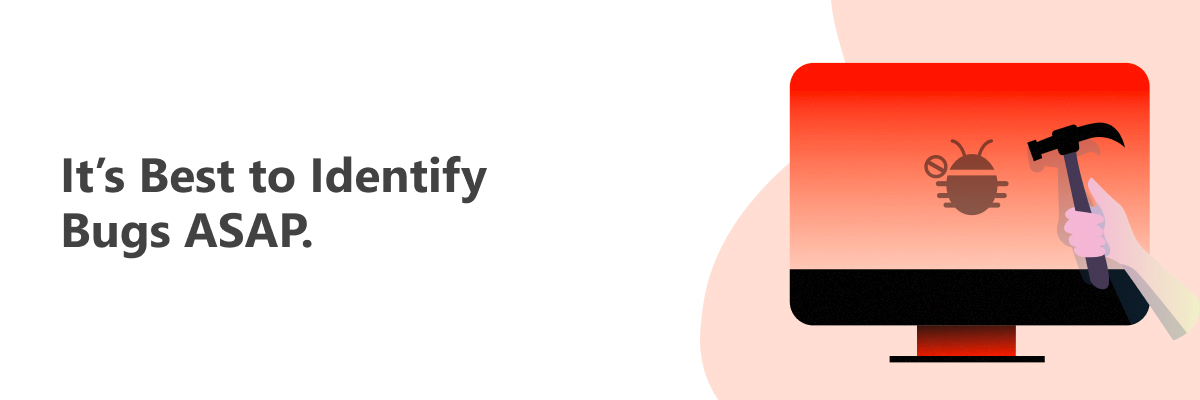
It is best to stick to an agile methodology of working when it comes to your app development. Ideally, the testing and development processes go hand in hand.
Even as your app is being developed, make sure you test each and every development for weakness and rectify it on the spot. If you let your errors sit stale, you will develop what is called a technical debt.
Think of the bugs you will likely encounter in your app development as real, live bugs. You know, the kind that flies around and freaks people out? If you don’t swat them to death immediately, they will reproduce and before you know it, it’s an infestation!
Similarly, if you wait till the end to start your testing process, you’ll have accumulated a technical debt that will be hard to resolve.
Launch Your App’s Beta Version
Once you launch your final product, or your Alpha version of the app, to the marketplace, there are no take backs. You’ll be hard-pressed to initiate an app recall if your target audience does not respond well to your final app. How can you avoid such a situation?
Well, you can start by testing the waters with a Beta version of your app. You need a minimum viable product, that is, your app’s Beta version, when you want to get user feedback and improve your final product. Your Beta version need not be fully functional or have all the features you plan to include in your Alpha version.
Consider the Dark Mode introduced by Google Chrome. Google did not change the theme of it’s millions of users overnight and ask them to deal with it. Instead, they released a Beta version to a limited number of people and asked them to download and try the exclusive Dark Mode feature. Based on the user reception and feedback, they integrated this functionality into their Alpha version.
It’s always good to have a fresh set of eyes to monitor your progress. And, your users are always ready to give you constructive feedback, because they know that they are the ultimate beneficiaries of your app’s capabilities. They will tell you what’s lacking and what issues need to be addressed if you just give them the chance to do so.
And also know the right time for your product launch.
Build Momentum
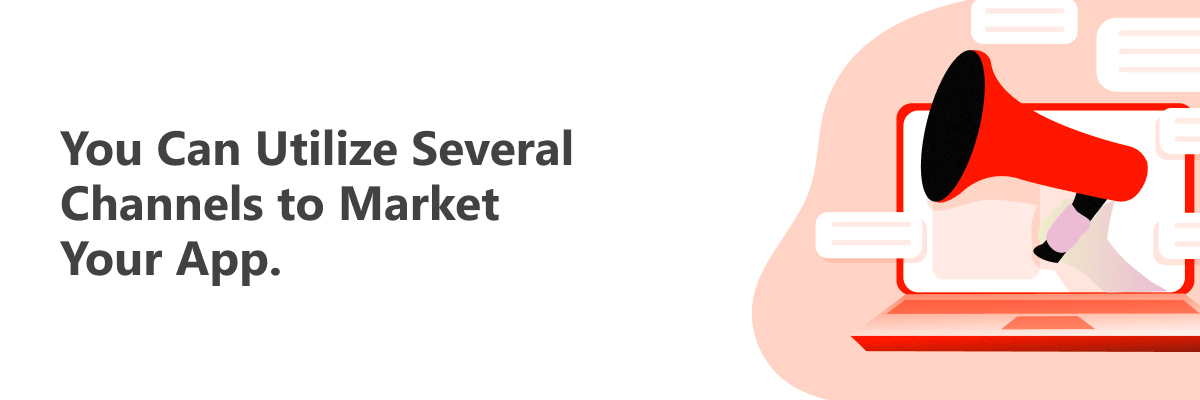
This is an important part of marketing your app to the right audience. Get a good marketing team to build momentum and give your app the traction it deserves!
There are several ways of promoting your app.
You can create interesting blogs and set up discussion forms to engage your target audience. This will help your potential users build a good rapport with your team and give their feedback as well. You can even create short and informative videos about how your app works, how to onboard your app, or how to navigate your user flow easily.
You can use social media channels to promote the content you create about your app and increase audience awareness about how your app can add value to their lives. You can also ask for reviews and feedback through surveys and questionnaires. Remember to keep these short as nobody wants to be bothered with long and boring lists of questions.
Launch Your App on Playstore
You’re almost there.
Create a developer account and launch your Alpha version to platforms like Google Playstore, so that the entire world has access to the wonderful app you have to offer.
There are a few pointers to keep in mind while doing so. Make sure your app has the visibility it requires and does not get buried alive under the hundreds of thousands of other apps available. You can do this with ASO or App Store Optimisation. ASO is similar to SEO, except it is used in helping the visibility of applications on the world wide web, as opposed to websites.
Carry out a proper ASO process and make sure your brand stands out. You will need an icon that will help your users recognise your app easily. You’ll need a good and easy-to-remember name for your app.
You will also need to give a few descriptive paragraphs about the features and functionalities of your app so that users know what they’re signing up for. Go the extra mile and throw in a few screenshots of your app as well to entice users with your app’s user-friendly interface.
Integrate Analytics Tools

When do you need analytics tools? Why were they not mentioned in any of the previous steps?
You only need analytic tools when you have an existing product and you want to optimize it. You can do this if you get data on how your customers are using your app.
Since you’ve already done extensive research on your target audience and your competition, you don’t need analytics tools before you launch your Alpha version. However, if you feel it will improve your delivery, go ahead and implement them into your final design before your Alpha version goes live.
So, why are analytics tools important for your app? They help you garner important insight into your customer’s behaviour and interactions with your app.
If you are selling products online, then these are some questions you can answer with the help of analytics. What is the most commonly bought item? Which products should you bundle together?
You can also utilise analytics tools to understand which areas or functionalities of your app you need to give more attention to. For example, let’s say you built a gaming app that has single-player and multiplayer modes. If you notice that your users tend to use the single-player mode much more than the multiplayer mode, you will know to put more resources into developing your multiplayer mode.
Keep Evolving
Your work is never done if you want an app that stays relevant in the marketplace. Read that again.
The marketplace is saturated with millions of apps every day, and it is up to you to make sure that you stand out from your competition.
As technology evolves, so will the expectations of your end users. They will expect more features, more engagement with your app, and more appealing interfaces. If you fail to keep up with your users’ demands, your retention rates will likely drop as users migrate to newer apps that cater to their demands.
You need to keep updating your app with the latest technology and most popular features to keep your audience interested.
Conclusion
There are no shortcuts to success. And there are no easy routes to a beautiful mobile app that can create delightful user experiences. We have provided an exhaustive list of the steps you need to follow to build your app from scratch. Now, it is up to you to ensure that you follow them sequentially for seamless project execution.
If you are a startup owner and are looking for the best team to assist you in mobile app development, a reliable company like NeoITO can help you. Our well-versed team can assist you in converting your idea into an app and ensure its successful launch.
Read on about the 21 Mobile App Development FAQs Every Startup Founder Must Know – A Detailed Guide

